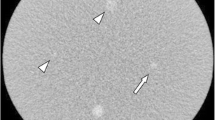Abstract
Objectives
This study was performed to evaluate the efficacy of a novel computed tomography (CT) liver detection algorithm (LDA), which allows for targeted increase of radiation dose to the upper abdomen, on image quality of the liver.
Methods
We retrospectively evaluated the LDA by comparing 40 consecutive patients who had portal venous CT abdomen performed without use of the algorithm, to 40 patients in whom the algorithm was used. Image quality was assessed objectively by comparing the standard deviation (SD) of attenuation values in Hounsfield units (HU) of the abdominal organs. Qualitative analysis was performed by two blinded radiologists who independently graded the image quality of abdominal organs
Results
There was significant noise reduction in the liver (P < 0.001) and spleen (P < 0.001) in the LDA group compared to the conventional group. There was also a significant improvement in image quality of the liver (P < 0.001), kidney (P < 0.001), spleen (P < 0.001), pancreas (P < 0.001), and psoas (P = 0.005) in the LDA group compared to the conventional group. Overall dose between the two groups was similar.
Conclusions
This liver detection algorithm improves the subjective image quality of upper abdominal organs, in particular the liver, without increasing overall radiation dose.






Similar content being viewed by others
Abbreviations
- CT:
-
Computed tomography
- DLP:
-
Dose length product
- HU:
-
Hounsfield units
- LDA:
-
Liver detection algorithm
- ROI:
-
Region of interest
- SD:
-
Standard deviation
References
Kalra MK, Maher MM, Blake MA, et al. (2004) Detection and characterization of lesions on low—radiation dose abdominal CT images postprocessed with noise reduction filters. Radiology 232(3):791–797
Funama Y, Awai K, Miyazaki O, et al. (2006) Improvement of low contrast detectability in low dose hepatic multidetector computed tomography using a novel adaptive filter: evaluation with a computer simulated liver including tumors. Invest Radiol 41:1–7
Baron RL (1994) Understanding and optimizing use of contrast material for CT of the liver. AJR Am J Roentgenol 163(2):323–331
Awai K, Takada K, Onishi H, Hori S (2002) Aortic and hepatic enhancement and tumor to liver contrast: analysis of the effect of different concentrations of contrast material at multi-detector row helical CT. Radiology 224:757–763
Kalpana MK, Chung JH, Wang J, et al. (2011) Image noise and liver lesion detection with MDCT: a phantom study. AJR Am J Roentgenol 197(2):437–441
Schindera ST, Torrente JC, Ruder TD, et al. (2011) Decreased detection of hypovascular liver tumours with MCDT in obese patients: a phantom study. AJR Am J Roentgenol 196(6):772–776
Baker ME, Dong F, Primak A, et al. (2012) Contrast-to-noise ratio and low-contrast object resolution on full- and low-dose MDCT: SAFIRE versus filtered back projection in a low-contrast object phantom and in the liver. AJR Am J Roentgenol 199(1):8–18
Mieville FA, Gudinchet F, Brunelle F, et al. (2013) Iterative reconstruction methods in two different MDCT scanners: Physical metrics and 4-alternative forced-choice detectability experiments—a phantom approach. Phys Med. 2012 Jan 2.
Robinson PJ (2000) Imaging liver metastases: current limitations and future prospects. Br J Radiol 73(867):234–241
Kalra MK, Maher MM, Toth TL, et al. (2004) Techniques and applications of automatic tube current modulation for CT. Radiology 233(3):649–657
Friedman B, Leyendecker JR, Blaufox MD, et al. (2014) Expert Panel on urologic imaging. ACR Appropriateness criteria lower urinary tract symptoms: suspicion of benign prostatic hyperplasia. American College of Radiology [Online publication]. Available from: http://www.guideline.gov/content.aspx?id=48292. Accessed on 22 Dec 2014
Andreotti RF, Lee SI, DeJesus Allison SO, et al. (2011) ACR Appropriateness criteria: acute pelvic pain in the reproductive age group. American College of Radiology [Online publication] Accessed 2014 October 22. Available from http://www.guideline.gov/content.aspx?id=32643. Accessed on Dec 2014
Harris RD, Javitt MC, Glanc P, et al. Expert Panel Women’s Imaging. (2012) ACR Appropriateness Criteria clinically suspected adnexal mass. American College of Radiology [Online publication]. Available from http://www.guideline.gov/content.aspx?id=48292. Accessed on 22 Dec 2014
Hodler RA Kubik-Huch, von Schuitness GK, Zollikofer CL (2014) Diseases of the Abdomen and Pelvis: diagnostic imaging and interventional techniques. Milan: Springer
McNamara MM, Lalani T, Camacho MA, et al. Expert Panel on Gastrointestinal Imaging. ACR Appropriateness Criteria left lower quadrant pain- suspected diverticulitis. American College of Radiology [Online publication]. Accessed Nov 2015
Author information
Authors and Affiliations
Corresponding author
Rights and permissions
About this article
Cite this article
Devapalasundaram, A., Lau, K.K., Paul, E. et al. Liver detection algorithm: its efficacy for CT noise reduction in the liver. Abdom Radiol 41, 493–499 (2016). https://doi.org/10.1007/s00261-015-0617-3
Published:
Issue Date:
DOI: https://doi.org/10.1007/s00261-015-0617-3




